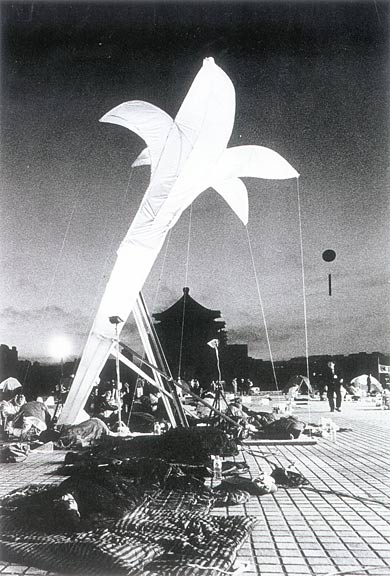The largest student movement in Taiwanese history, the Wild Lily Student Movement was a major event that eventually led the Taiwanese government to reform into the democracy that it is today.
Background
In 1986, members of the Tang-Wai movement officially formed the Democratic Progressive Party (DPP), despite the ruling Kuomintang party’s ban on opposition parties. However, the KMT did not take any actions against them at the time, leading to the DPP’s legalization in 1991.
In 1988, President Chiang Jing-Kuo passed away, and his vice president, Lee Teng-Hui, took over his presidential position. The next presidential selection was scheduled for 1990. However, at this time, candidates for President and Vice President of the Republic of China (ROC) were selected from the National Assembly (國民大會). The National Assembly had the nickname “Ten Thousand Year Assembly” (萬年國會) because no new local Taiwanese representatives had joined since the ROC’s retreat to Taiwan.
In 1989, the Tiananmen Square protests, student-led demonstrations for democratic reform in China, resulted in the Tiananmen Square Massacre. Taiwan had a mass protest, the Wild Lily Student Movement, the following year.
As momentous change unfolded around the world, Taiwan quietly underwent its own democratic reform.
CommonWealth Magazine
Protest
March 16, 1990
Nine students from National Taiwan University (NTU) held a sit-in protest at the Chiang Kai-Shek (CKS) Memorial Hall. After hearing this, many other students and non-governmental organizations came to join them.
March 17, 1990
By the evening, 200+ students took part in the sit-in protest. Over 2,000 people were around to support them.
NTU liberals skipped class to attend the protests at CKS Memorial Hall, designating the week as a “civic education week” of real-world learning. Students from many other schools joined them.

March 18, 1990
On this day, the organizing committee made four demands:
- Dissolve the National Assembly (國民大會) and re-establish a new National Assembly infrastructure
- Nullify the Temporary Provisions Against the Communist Rebellion (動員戡亂時期臨時條款) and re-establish constitutional order
- Hold a National Affairs Conference (國是會議)
- Establish a political reform timetable
 March 19, 1990
March 19, 1990
The protestors chose the Formosan Lily (Lilium formosanum) as the movement’s symbol for the following reasons:
Autonomy
As a species of lily native to Taiwan, the Formosan Lily reflected that the movement was homegrown, and thus autonomous from foreign ideals.
Grassroot
Found from the mountains all the way to the coast, the Formosan Lily reflected the grassroots aspect of the movement.
Vitality
Formosan Lilies can bloom even in the worst of conditions.
Spring Bloom
The movement took place in the spring, when Formosan Lilies bloom. This characteristic of the lily also represented the students’ youth because of the spring season’s association with youth (the second character in the Mandarin word for ‘youth’, 青春, is the character for ‘spring’).
Purity
The Formosan Lily’s pure white color represented the students’ innocence and purity.
Honor
In the Lukai Tribe, an indigenous tribe of Taiwan, the Formosan Lily symbolized honor.
March 20, 1990
By this day, over 5,000 protestor had gathered at the CKS Memorial Hall. With the presidential selection scheduled for the next day, March 21, tensions were high. The government, department of education, and principals from all schools demanded that students resume attending classes.

March 21, 1990
Newly selected President Lee Teng-Hui invited 53 students to the Presidential Office. President Lee agreed to accomplish the protestors’ four demands before his inauguration.
Upon reviewing the footage of President Lee‘s meeting with the students, the organizing committee agreed to end the student movement on March 22.
March 22, 1990
Participation grew to over 20,000 protestors. This day marked the end of the six-day student movement known as the Wild Lily Student Movement, Taiwan’s first large-scale student movement.
Legacy:
A National Affairs Conference was held in 1990.
The National Assembly was disbanded in 1991.
The Temporary Provisions Against the Communist Rebellion were nullified in 1991.
These changes enabled a free and democratic election in which the Taiwanese people could cast their own ballots. In 1996, Taiwan held its first true democratic election, and President Lee was re-elected for his final term in office.
References:

Thank you for this post and for writing in English, really helps me 🙂
LikeLike